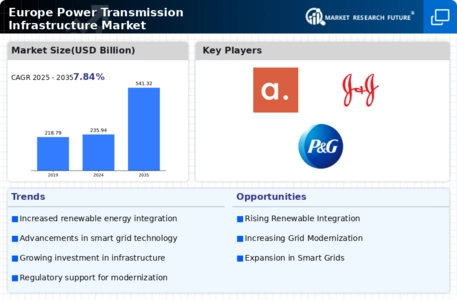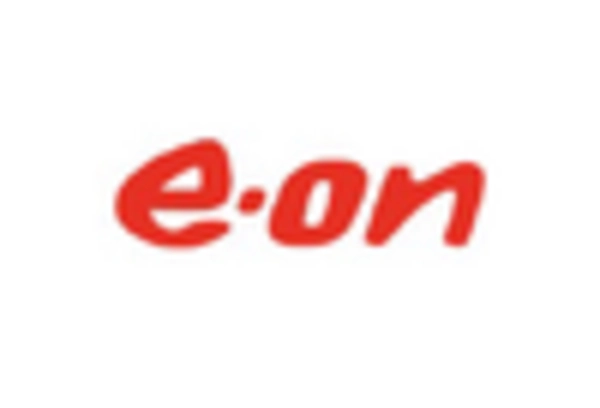Increasing Demand for Electricity
The Europe Power Transmission Infrastructure Market is experiencing a notable surge in electricity demand, driven by urbanization and industrial growth. As populations in urban areas expand, the need for reliable and efficient power transmission becomes paramount. According to recent data, electricity consumption in Europe is projected to rise by approximately 1.5% annually over the next decade. This increasing demand necessitates the enhancement of existing transmission networks and the construction of new infrastructure to ensure that supply meets the growing needs of consumers and industries alike. Consequently, investments in power transmission infrastructure are likely to escalate, fostering innovation and modernization within the sector.
Focus on Energy Security and Resilience
Energy security remains a critical concern for the Europe Power Transmission Infrastructure Market, particularly in light of geopolitical tensions and climate change. Ensuring a resilient power transmission network is essential for maintaining stable electricity supply and minimizing disruptions. Governments are increasingly prioritizing investments in infrastructure that can withstand extreme weather events and other potential threats. The European Commission has identified the need for a more resilient energy system, leading to initiatives aimed at reinforcing transmission networks. This focus on security and resilience is likely to drive further investments in infrastructure, ensuring that the power transmission sector can adapt to evolving challenges.
Integration of Renewable Energy Sources
The transition towards renewable energy sources is a pivotal driver for the Europe Power Transmission Infrastructure Market. As countries commit to reducing carbon emissions, the integration of wind, solar, and other renewable energy sources into the grid becomes essential. This shift necessitates the development of new transmission lines and upgrades to existing infrastructure to accommodate the variable nature of renewable energy generation. According to estimates, investments in renewable energy infrastructure could exceed EUR 1 trillion by 2030, highlighting the urgency for enhanced transmission capabilities. This integration not only supports sustainability goals but also stimulates economic growth within the power transmission sector.
Regulatory Support for Infrastructure Development
The Europe Power Transmission Infrastructure Market benefits from robust regulatory frameworks that promote infrastructure development. Governments across Europe are implementing policies aimed at enhancing energy security and sustainability. For instance, the European Union has set ambitious targets for reducing greenhouse gas emissions, which necessitates significant upgrades to power transmission systems. The Clean Energy for All Europeans package outlines measures to facilitate investments in energy infrastructure, thereby creating a conducive environment for market growth. This regulatory support is expected to drive investments in new transmission lines and technologies, ultimately enhancing the efficiency and reliability of power delivery across the continent.
Technological Advancements in Transmission Systems
Technological innovations are playing a crucial role in shaping the Europe Power Transmission Infrastructure Market. The advent of high-voltage direct current (HVDC) technology, for instance, allows for more efficient long-distance power transmission with reduced losses. Additionally, advancements in monitoring and control systems enable real-time data analysis, enhancing grid reliability and operational efficiency. The integration of smart grid technologies is also facilitating better management of electricity flows, accommodating the increasing share of renewable energy sources. As these technologies continue to evolve, they are likely to attract significant investments, further propelling the growth of the power transmission infrastructure sector.


















Leave a Comment